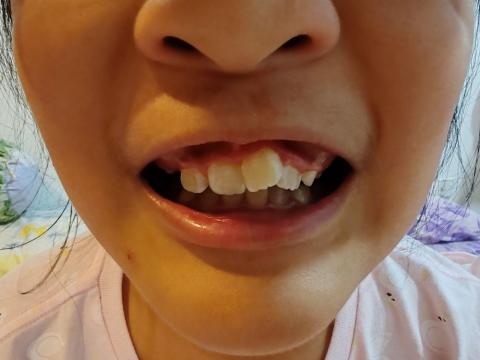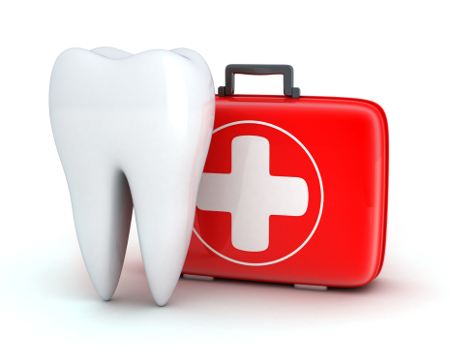Your Smile, Perfected with Precision.
10 Year-Old with Crooked Front Teeth: Understanding Early Tooth Misalignment and When to See the Dentist
Severity:
Teeth Problems:
Quick summary (one-line)
This looks like a typical mixed-dentition alignment issue in a ~10-year-old: the upper front permanent incisors are crowded/rotated and erupting unevenly. It’s common and usually treatable, but a dental exam and X-rays are recommended to plan the right timing and treatment.
What I see (photo-based findings)
-
Mixed dentition: permanent upper incisors are present and some primary teeth remain (normal at this age).
-
Upper central/lateral incisors appear crowded and one incisor is rotated/overlapping its neighbor.
-
Slight gingival prominence above the incisors (likely normal eruption tissue rather than infection).
-
No obvious pus, major swelling, or traumatic injury visible in the photo.
Likely causes
-
Arch (jaw) size too small for the erupting permanent teeth → crowding/rotation.
-
Normal eruption sequence and timing variability (some teeth erupt rotated then self-align a bit).
-
Possible retained primary tooth or lack of space from early loss of a baby tooth (can contribute).
-
Less likely from trauma or infection based on this photo.
Red flags (seek urgent care if any are present)
Go to a dentist right away if your daughter has:
-
Significant pain, spreading facial swelling, fever, or difficulty breathing/swallowing.
-
A loose tooth that is very mobile or any pus/drainage.
If none of the above, it’s not an emergency.
What the dentist will likely do / what I recommend next
-
Clinical exam + dental X-rays (panoramic or bitewing/PA) to check tooth positions, unerupted teeth, root development, and whether any supernumerary tooth or retained roots are present.
-
Monitor vs. interceptive treatment decision:
-
If space is adequate and eruption is ongoing, dentist may monitor for a few months — many minor rotations improve as neighboring teeth erupt.
-
If space deficiency or asymmetric eruption is present, an interceptive approach may be recommended (removal of a retained primary tooth, space regaining, or other simple measures).
-
-
Referral to a pediatric dentist or orthodontist for alignment planning if crowding is significant.
-
Possible treatments later: fixed braces (metal/ceramic) or aligners once more permanent teeth are present; sometimes simple removable appliances or extraction of specific baby teeth are used earlier to guide eruption.
Timeframes — realistic expectations
-
Change in 14 days: unlikely. Teeth do not meaningfully realign in two weeks.
-
Short-term monitoring: 1–6 months (to let eruption continue and decide if interceptive steps are needed).
-
Interceptive treatment (if recommended) may take months (6–12 months) to create space or guide eruption.
-
Comprehensive orthodontic treatment (braces) usually occurs later and commonly lasts 12–36 months, depending on severity.
What could happen if left untreated
-
Crowding/rotation may persist or get worse as more permanent teeth erupt.
-
Increased risk of bite problems (malocclusion), abnormal wear, difficulty cleaning leading to cavities or gum inflammation, and possible psychosocial effects (self-consciousness).
-
Many children can wait until growth allows full orthodontic treatment; but early intervention is helpful in some cases.
At-home care now
-
Maintain excellent brushing and flossing to avoid cavities or gum inflammation around erupting teeth.
-
Soft diet if any tenderness.
-
Avoid hard poking at loose primary teeth.
-
Observe for pain, swelling, or changes — report them to your dentist.
Recommended next step
Book a check with a pediatric dentist or general dentist for exam + radiographs. If you want to pick a clinic near you, you can search the directory you mentioned: https://cebudentalimplants.com/map-dental-clinic — take these photos and the age info to the appointment.
Final practical advice
-
Don’t panic — this is common and usually manageable.
-
If there’s no pain or swelling, an appointment in the next 2–6 weeks for an exam and X-ray is reasonable.
-
If the child is distressed by appearance, mention that to the dentist; they can advise whether earlier interceptive steps are appropriate.
If you’d like, I can:
-
Draft a short message you can copy to the dentist describing the problem and what you want checked; or
-
List specific questions to ask the pediatric dentist/orthodontist at the visit.





